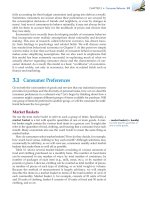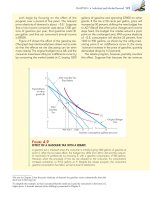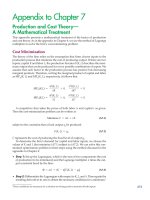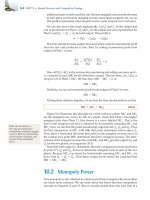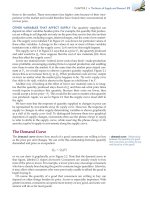(8th edition) (the pearson series in economics) robert pindyck, daniel rubinfeld microecon 144
Bạn đang xem bản rút gọn của tài liệu. Xem và tải ngay bản đầy đủ của tài liệu tại đây (78.48 KB, 1 trang )
CHAPTER 4 • Individual and Market Demand 119
If the price of a movie ticket rises, we would expect individuals to rent more
videos, because movie tickets and videos are substitutes. Similarly, two goods
are complements if an increase in the price of one good leads to a decrease in
the quantity demanded of the other. If the price of gasoline goes up, causing
gasoline consumption to fall, we would expect the consumption of motor oil
to fall as well, because gasoline and motor oil are used together. Two goods are
independent if a change in the price of one good has no effect on the quantity
demanded of the other.
One way to see whether two goods are complements or substitutes is to
examine the price-consumption curve. Look again at Figure 4.1 (page 113). Note
that in the downward-sloping portion of the price-consumption curve, food and
clothing are substitutes: The lower price of food leads to a lower consumption
of clothing (perhaps because as food expenditures increase, less income is available to spend on clothing). Similarly, food and clothing are complements in the
upward-sloping portion of the curve: The lower price of food leads to higher
clothing consumption (perhaps because the consumer eats more meals at restaurants and must be suitably dressed).
The fact that goods can be complements or substitutes suggests that when
studying the effects of price changes in one market, it may be important to look
at the consequences in related markets. (Interrelationships among markets are
discussed in more detail in Chapter 16.) Determining whether two goods are
complements, substitutes, or independent goods is ultimately an empirical
question. To answer the question, we need to look at the ways in which the
demand for the first good shifts (if at all) in response to a change in the price of
the second. This question is more difficult than it sounds because lots of things
are likely to be changing at the same time that the price of the first good changes.
In fact, Section 4.6 of this chapter is devoted to examining ways to distinguish
empirically among the many possible explanations for a change in the demand
for the second good. First, however, it will be useful to undertake a basic theoretical exercise. In the next section, we delve into the ways in which a change in
the price of a good can affect consumer demand.
4.2 Income and Substitution Effects
A fall in the price of a good has two effects:
1. Consumers will tend to buy more of the good that has become cheaper
and less of those goods that are now relatively more expensive. This
response to a change in the relative prices of goods is called the substitution effect.
2. Because one of the goods is now cheaper, consumers enjoy an increase in
real purchasing power. They are better off because they can buy the same
amount of the good for less money, and thus have money left over for
additional purchases. The change in demand resulting from this change in
real purchasing power is called the income effect.
Normally, these two effects occur simultaneously, but it will be useful to
distinguish between them for purposes of analysis. The specifics are illustrated
in Figure 4.6, where the initial budget line is RS and there are two goods, food
and clothing. Here, the consumer maximizes utility by choosing the market
basket at A, thereby obtaining the level of utility associated with the indifference curve U1.

